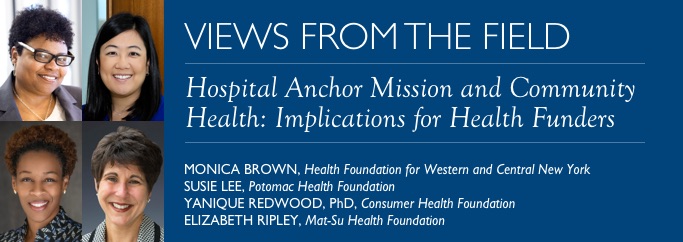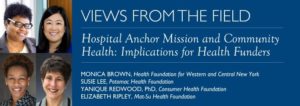
In 2017, 30 U.S. health systems came together to form the Healthcare Anchor Network. These systems together comprise more than 600 hospitals with a million employees, $50 billion in spending on goods and services, and $150 billion in investment assets. This unprecedented health system-led collaboration seeks to address the root causes of poor health through strategies that build inclusive and sustainable local economies (Healthcare Anchor Network, 2017). By engaging the health care sector in leveraging its vast institutional assets, the ultimate goal is to have a powerful impact on the upstream factors that drive health outcomes (Zuckerman, 2017).
In parallel, a group of funders, working in partnership with Grantmakers In Health (GIH), developed a health funder learning journey to understand this health care evolution and examine how hospitals and health systems can more effectively advance health equity in partnership with health funders. Health funders can play many roles, including:
- convening multiple institutions as trusted partners,
- conveying a sense of urgency to spur action,
- catalyzing initial progress and early wins,
- communicating a powerful new vision for community health,
- committing and partnering for the long-term,
- co-investing to strengthen the eco-system, and
- creating the evidence base and long-term business case to help sustain these strategies (Kelly, 2014; Pease, 2017).
Understanding an Anchor Mission
Anchor institutions are nonprofit or public place-based entities such as hospitals, universities, local governments, and foundations that are rooted in place by mission, invested capital, or relationships to customers, employees, and residents. They have become the largest employers and economic engines of their communities with the potential to leverage their hiring, purchasing, and investing assets along with their human capital in partnership with their communities to mutually benefit the long-term well-being of both. By taking this intentional step, they are adopting an “anchor mission” (Martin, 2017).
With more than 5.6 million employees, expenditures of $780 billion and an estimated $400 billion in investment portfolios, health systems are significant anchor institutions. Around the country, they are increasingly recognizing that for them to fulfill their mission of improving health they must address the social, economic, and environmental root causes of poor health (Howard, 2015).
These root causes have translated into life expectancy gaps that exceed 20 years between zip codes just a few miles apart and differences in lifespan nationally between the richest and the poorest that have more than doubled since the 1970s. These outcomes link back to poor economic conditions—amplified by racial inequities. A new approach is essential for eliminating these inequities (Maciag, 2016).
Our Learning Journey
Our learning journey began at the 2016 GIH Annual Conference on Health Philanthropy at a dinner meeting entitled “Can Hospitals Heal America’s Communities?” GIH then hosted two webinars on how hospitals and health systems can 1) leverage community health needs assessments (CHNAs) to advance the social determinants of health and 2) advance economic justice by leveraging their hiring and procurement functions and impact investments. At the GIH 2017 conference, we hosted a second dinner conversation to deepen the dialogue and introduce health funders to the Healthcare Anchor Network.
At our first dinner, Kaiser Permanente shared their “Total Health” strategy, seeking to deploy and align its organizational assets beyond community benefit dollars, such as procurement, hiring and investment portfolio, to improve health and well-being. For example, in West Baltimore, they are developing intentional career pipelines for local residents (McDaniels, 2017).
Later in 2016, Mat-Su Health Foundation, St. Joseph Health, and Kaiser Permanente shared how nonprofit health systems are broadening community input into their CHNA processes and expanding the definition of health to include the factors that impact health such as economic and housing insecurity, early childhood development, and access to education (Grantmakers in Health, 2016).
In early 2017, Rush University Medical Center, Johns Hopkins Health System, and RWJBarnabas Health discussed the difficult but important work of embedding an anchor mission into health system operations and cultures (Grantmakers in Health, 2017). All shared the potential impact of leveraging everyday business operations to create economic opportunity and improve community health (Rush University Medical Center, 2017).
Finally, at our GIH dinner in June 2017, Partners Healthcare and Boston Medical Center (BMC) discussed the importance of powerfully articulating a burning platform to move large institutions in this new way. BMC, in particular, called out Medicaid expansion and the affordable housing crisis as levers it is using to accelerate its anchor mission strategies.
Our Role as Health Funders
This journey illuminated many roles that we, as health funders and anchors ourselves, could play to support and accompany these institutions in advancing their anchor missions. Summarized above, here we highlight three that surfaced through our learning journey.
Convene: Funders are often seen as trusted partners and can help create or sustain this conversation among health system peers. For example, in Boston, the Blue Cross Blue Shield of Massachusetts Foundation has helped convene health systems to do just this.
Convey: The current way of doing business and day-to-day crises create inertia to long-term planning and acting. Funders can spur individual institutions to action by helping them define a powerful organizational imperative or “burning platform” for an anchor mission approach. The Mat-Su Health Foundation, in reorienting the CHNA, has helped broaden the conversation about the role of health systems in addressing upstream factors that negatively impact health.
Co-invest: For anchor institutions to effectively leverage their hiring, purchasing, and investing capabilities, they need strong community partners and a local eco-system. The Polk Bros. Foundation has been a critical co-investor in Chicago Anchors for a Strong Economy—an intermediary to support anchors in buying, hiring, and investing locally.
In the work ahead, we have what we need to meaningfully improve health and well-being. As funders, we need to leverage our roles to drive systems changes that will narrow and eliminate health inequities. As one health system Chief Executive said, this work requires courage. We have also learned that it requires intention and a shift to strategies that emphasize a new way of doing business for health systems, health funders, and the largest anchor institutions in our communities.
References
Grantmakers in Health, “Community Health Needs Assessments that Advance the Social Determinants of Health,” September 20, 2016, https://www.gih.org/Audio/AudioDetail.cfm?itemnumber=8193.
Grantmakers in Health, “Hospitals and Health Systems as Drivers of a Health-Promoting Economy,” February 28, 2017, https://www.gih.org/Audio/AudioDetail.cfm?itemnumber=8420.
Healthcare Anchor Network, “Healthcare Anchor Network, 2017, healthcareanchor.network.
Howard, Ted and Tyler Norris, Can Hospitals Heal America’s Communities?: “All in for Mission” is the Emerging Model for Impact, Takoma Park, MD: The Democracy Collaborative, December 2015, https://democracycollaborative.org/content/can-hospitals-heal-americas-communities-0.
Kelly, Marjorie and Violeta Duncan, A New Anchor Mission for a New Century: Community foundations deploying all resources to build community wealth, Takoma Park, MD: The Democracy Collaborative, November 2014, https://democracycollaborative.org/new-anchor-mission.
Maciag, Mike, “Live Expectancy Varies Greatly Within Cities,” Governing, February 3, 2016, https://www.governing.com/topics/health-human-services/gov-life-expectancy-neighborhood.html.
Martin, Nancy, on behalf of the Healthcare Anchor Network, Advancing the Anchor Mission of Healthcare, Washington, DC: The Democracy Collaborative, March 2017, https://democracycollaborative.org/han.
McDaniels, Andrea, “Kaiser, Bon Secours join forces on plan to improve health through economic opportunity, Baltimore, MD: The Baltimore Sun, July 5, 2017, https://www.baltimoresun.com/health/health-care/bs-hs-kaiser-bon-secours-20170704-story.html, November 2017.
Pease, Katherine, Anchored in Place: How Funders are Helping Anchor Institutions Strengthen Local Economies, Coral Gables, FL: Funders’ Network for Smart Growth and Livable Communities, August 2017, https://www.fundersnetwork.org/funders-network-anchored-in-place/?mc_cid=c042c64aa9&mc_eid=5f78664316.
Rush University Medical Center, Anchor Mission Playbook, Washington, DC: The Democracy Collaborative, August 2017, https://www.rush.edu/sites/default/files/anchor-mission-playbook.pdf.
Sabrina Tavernise, “Disparity in Life Spans of the Rich and the Poor Is Growing,” New York Times, February 12, 2016, www.nytimes.com/2016/02/13/health/disparity-in-life-spans-of-the-rich-and-the-poor-is-growing.html, accessed November 2017.
Zuckerman, David and Katie Parker, Hospitals Aligned for Healthy Communities, Washington, DC: The Democracy Collaborative, 2017, hospitaltoolkits.org.

